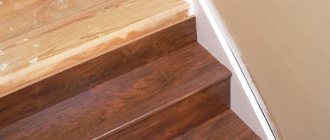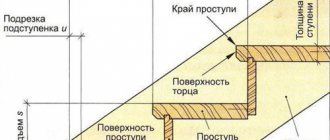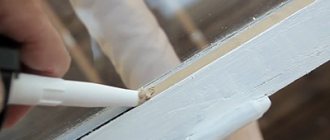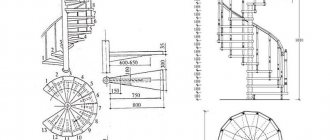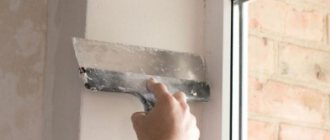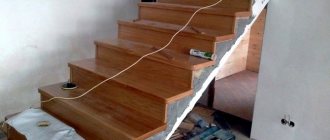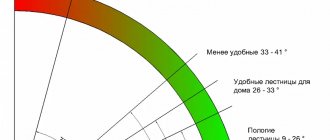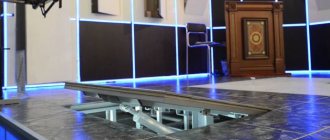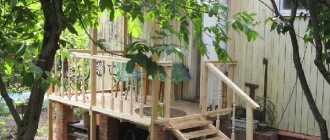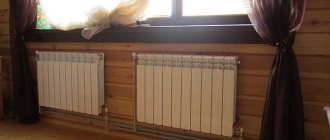How is the staircase indicated in the drawing? How to draw a staircase in AutoCAD, what should be its slope and the size of the steps? What are the correct names for the structural elements of a flight of stairs? We will try to find answers to these and some other questions in the article.
A person who is not deprived of artistic talent can draw the staircase of his dreams. But the builder will not understand him.
Building plan
Typically, a staircase drawing is part of a building or floor plan. We will begin by introducing the concept of a plan.
It is worth clarifying: of course, when manufacturing any complex structures, a detailed sketch is also drawn up, indicating those dimensions that are usually absent on the building plan. However, the staircase is in any case indicated on the general plan.
So, a plan is a projection of a horizontal section of a floor or an entire house onto a plane. What information does it contain?
- The location of all rooms on the floor, indicating their sizes.
- Location of staircases and flights.
- The location of window and door openings also depends on their dimensions, of course.
- Building structure (including location of supports and floor spans).
- Thickness of load-bearing walls and columns.
Drawing up plans is subject to certain rules:
- The main facade is at the bottom of the plan.
Cottage floor plan. The façade is below.
- If there are plans of several floors on one sheet, they are arranged in ascending order of the floor number from left to right or from top to bottom.
- The plan indicates the direction in which the doors will open.
- The drawing of a flight of stairs is supplemented with an arrow indicating the slope from bottom to top: the beginning of the arrow is always at the bottom of the flight.
Main types of staircase structures
Let's consider the existing types of staircase structures:
- according to their purpose, stairs can be between floors, entrance from the street, inside the house or used for design;
- by design they can be spiral, folding, circular, single-flight or multi-flight;
- stairs can be open or closed, and also differ in the shape of the steps.
Design features
Stairs can also differ in landings, which can be oval, round, square, rectangular and curved. The steps can be open with open space under the steps, or closed when risers are installed between the steps.
Popular varieties
Terminology
What are the correct names for ready-made staircases of various types and their elements?
Types of stairs
- A spiral staircase is twisted around a pillar. Its characteristic feature is triangular or trapezoidal steps. Typically used when space is at a premium; quite inconvenient for transporting large items.
- Marching is its complete opposite: rectangular feet and straight lines.
- A spiral staircase differs from a spiral staircase in that it describes a circle away from the geometric center.
- The cantilever does not have a supporting frame - the steps are embedded in the wall on one side.
- Modular is assembled from identical structural elements. The connections remain detachable.
Ready-made stairs - features of modern designs
- the bolts use steel elements as support that connect the steps to each other - bolts.
- Attic and basement stairs differ from others quite conventionally: they are characterized by a greater slope. The reason is high requirements for compactness and low requirements for convenience. However, they may not differ from interfloor ones: saving space is not required everywhere.
- Firefighters can be either marching or vertical. Vertical stairs with a height of more than six meters are equipped with railings.
In addition to appearance and purpose, stairs can differ in material. Popular materials for making them yourself are reinforced concrete, steel and wood; Along with them, more exotic ones can be used: glass, artificial or natural stone, ceramics and some plastics.
Please note: the exception is stationary fire escapes. They are made only from steel.
Attic stairs - what are they?
Elements
- The flight we have already mentioned is just a straight section of the stairs.
- Tread is the horizontal surface of a step.
- A riser is a vertical structural element that supports a tread.
However: spiral, cantilever and some flight staircases often do without risers.
- Stringer is a support beam with steps on top of it. Most often there are two stringers, but some designs make do with one.
- If the steps do not rest on the beams, but are embedded between them, the beams are called bowstrings.
- A landing is a horizontal section between two flights.
- Winder stair steps are an alternative to the platform between two multidirectional flights. Unlike straight flight steps, they have a trapezoidal shape.
- The center line, contrary to its name, does not necessarily run through the center of the staircase. This is an imaginary line along which one person ascends or descends in the absence of factors limiting movement. Let's say, for a spiral staircase, the middle line will be slightly shifted towards the wider edge of the step.
- Clearance is, simply put, the distance from the surface of the step to what is above your head when you stand on it.
Blind areas
A blind area means a concrete or asphalt waterproof strip located around a building. It is arranged around the perimeter of the building and has a slope towards it. Its main purpose is to protect the foundation from rain and melt water.
To create a blind area, materials such as asphalt, concrete, brick, gravel, and crushed stone are used. Its width depends on factors such as the height of the roof eaves and the type of soil, but cannot be less than 100 centimeters.
Designations on the drawings
How to correctly designate stairs in drawings?
Form
No exotic awaits us here: the image of the staircase in the drawing is its projection onto a plane. If we try to depict a floor in plan - on a horizontal one; in the case of a vertical section - accordingly, to the vertical one.
Usually the plan does not give a complete picture of the number of flights and vertical dimensions of the staircase, so the drawing of the staircase and flights is carried out at least in plan and one section.
Steps for stairs - shape, material, design features
As already mentioned, the designation of the stairs in the drawing is necessarily supplemented by an indication of the direction in which the stairs are climbed. The bottom of the stairs is marked with a circle, the top with an arrow.
The diagram shows designations for complex-shaped stairs, ramps and doors.
Materials
Should, say, drawings for concrete stairs necessarily include a verbal or letter designation of the material from which they are made?
Not at all. GOST 5401-50 contains instructions on the use of graphic symbols for various materials in construction.
Pessimist Comment: When drawing a house or staircase by hand, properly shading the relevant elements of the image is much more difficult than writing a few words in a footnote.
Here is a description of the graphic symbols for those materials that are used in the construction of stairs.
- The tree in the transverse end section is hatched with circular and radial lines, imitating annual rings and radial cracks. Longitudinal lines are depicted on the longitudinal section - imitation of texture. If the material of a wooden staircase does not fall within the cut line, it is not shaded.
- Concrete is represented by a combination of dots and irregularly shaped circles. If the concrete staircase is reinforced (in fact, otherwise self-supporting structures are not made from concrete), the circles are combined with diagonal shading.
- Steel and generally metal structural elements are hatched with frequent diagonal lines. In small-scale drawings or when the element thickness is less than 2 mm, they are marked with a solid fill.
Designations of some building materials not included in our list.
How to order turnkey production and installation of staircases - prices, catalogs
The table below shows prices for some designs. Catalogs with different models and full descriptions can be found on the Internet.
| Photo | Company and model | Description | Average price, rub. |
| "Stairs prosto.ru" Pine staircase LS -5M | Height – 2700. Material pine. You can turn right or left. 13 steps. | 33 600 | |
| LLC "RAM" Stainless steel staircase. | The shape is straight. Silver color. Plastic or metal handrails. There are straight and screw models. | From 45 000 | |
| "Moscow Stairs" Moslest Progmatik | There are 14 steps available. Height 3-3.8 meters. March width 940 mm. | 60 000 | |
| Dolle “Chicago” M 12 Ready-made modular staircase | 12 steps. The width of the steps is 900 mm. Silver metal combined with varnished beech. Step height of the step is 18-22 cm. | 90 000 | |
| Profi Hobby “K-003M/2” | Material: pine. Dimensions -1820-1560. Height – 2925. 15 steps. U-shaped staircase. | 39 990 | |
| Factory of stairs "Stolyarych" Prestige | The body and steps are birch. Risers and balusters are pine. It is possible to use 13 painting options. | From 75,000 to 240,000 |
General principles and dimensions
The project cost is typically 1 to 5 percent of construction. If we are talking about the manufacture of a staircase, its detailed sketch may well cost 1/10 of the total cost of the structure.
Of course, someone who hasn’t skipped school drawing lessons will have a reasonable desire to do the work themselves. However, this requires not only enthusiasm, but also certain basic knowledge.
Slope
- The most convenient slope is 1:2, or 30 degrees to the horizon. Comfort range - from 25 to 40 degrees; the maximum permissible slope for an interfloor staircase is 45 degrees (1:1).
However: drawings of attic stairs are made based on a slope of up to 75 degrees. The reasons have already been mentioned: for rarely visited rooms, the compactness of the staircase is more important than comfort.
- With a slope of less than 23 degrees, it is possible to construct a ramp - a straight or curved inclined platform.
- An angle to the horizon of more than 45-50 degrees means that you will have to go down the stairs backwards. A person descending such stairs will be hampered by the length of his own shins.
The photo shows a rather steep staircase
Basic moments
- The march contains no less than three and no more than eighteen steps. The limitation is related to safety: the longer the ladder, the greater the likelihood of serious injury if falling from it.
- All steps within a straight flight must be strictly identical. The requirement again relates to safety, but this time to fire safety: you will have to descend in a smoky room from memory, placing your feet literally by touch.
- Staircase drawings are made taking into account one more safety requirement: the length and width of the platform separating flights lying on the same straight line should not be less than the width of the stairs. Everything is clear with the width of the site: otherwise it will become a bottleneck; but why regulate the length?
So that a person who has lost his balance has the opportunity to stop.
- If we are talking about an external staircase, then it is better to make the door leading to it open inward. Where this is not possible, the platform is made deliberately wider than the door leaf.
Dimensions
Well, what are the optimal and minimum sizes to adhere to when designing?
The width of the staircase is related to its functionality. If it is designed for one person, a reasonable minimum is 90 centimeters. Actually, according to SNiP 31-02, at least one interfloor staircase in a private house must have a width no less than this.
The optimal width of the staircase is determined by its purpose.
However: for apartment buildings the minimum is 1050 mm. If you plan to move two opposing streams of people up the stairs, it is worth expanding it to at least 1500 mm.
The minimum height of the fence for a private house is 90 cm; if the height of the stairs is more than six meters, the fence should not be lower than 100 cm.
The dimensions of the step must meet several requirements:
- Tread width - from 260 to 355 millimeters . The entire foot of a tall person must fit on it: otherwise, climbing the stairs will be accompanied by constant tension in the calf muscles.
- The height of the step is from 125 to 200 millimeters . In this case, the ratio of width and height should, recall, ensure the slope of the march in a comfortable range. From a convenience point of view, a step with a width of 300 and a height of 150 mm is ideal.
The paths to attics and basements also stand apart in this case. As you can see, this drawing of an attic staircase indicates a tread width of only 199 mm with a step height of 230.
- The sum of the width of the tread and twice the height of the step should be equal to the average step (usually 60 - 64 centimeters).
For spiral, spiral staircases and for winder steps, there is an optimal turning radius. It is equal to the sum of twice the width of the tread and the width of the stairs. In this case, the tread is measured not along the edge, but along the center line.
So, with a staircase width of 100 cm and a tread width on the center line of 20 cm (this is the minimum prescribed by SNiP), the turning radius should not be less than 100+(20x2)=140 cm.
The clearance (remember, this is the distance from the step to the ceiling) is made no less than 2000 mm. In this case, a tall person will not have to bend down.
The clearance should leave at least 10 centimeters of free space above the head of the tallest inhabitant of the house.
Calculation of stairs
In the process of drawing up a project and creating a sectional staircase, it is necessary to take into account certain conditions and requirements. The master must understand what type of movement the main structure should be designed for. Also, first of all, it is necessary to understand what loads will be encountered during operation. Types of stairs designed only for people or moving cargo will be completely different.
Specialists should also take into account the parameters that determine the difference between levels or floors, the shape and area of the room where the structure will be located. After the type of staircase is finally determined, you need to designate its parameters. This means the following:
- lifting height;
- area of the staircase structure;
- slope;
- number of steps and marches;
- the width of each step and tread.
It is necessary to calculate several factors.
The master must understand that there is a certain relationship between each of the elements, which is why the parameters of staircase structures are not determined at will. If we talk about the area of straight stairs, there is a dependence on the height of the slope and rise, and these characteristics, in turn, will determine the calculations regarding the slope.
When a staircase project is being developed, some design characteristics are always set by the master, and the rest are determined using calculations. For example, if a person knows and has marked the area of the stairs on paper, this can be used to calculate the slope, as well as determine the required steps and their number.
When calculations are made regarding the elements of the stairs, the width of the flight of stairs is of great importance. In this case, it is necessary to take into account that for a comfortable passage through the structure of one person, approximately 600-700 mm is sufficient.
Note! If the structure involves in the future the presence of oncoming traffic or the need to carry any bulky objects, then the width of the structure should not be less than 850-1000 mm. But at the same time, it is advisable to build the staircase as simple as possible in configuration and place it along one of the walls in the room.
Before proceeding directly to the creation of the project, it is worthwhile to accurately determine the dimensions of the stair elements. To do this, the location of the structure is indicated on paper, as well as the dimensions of the structure, step diagrams and the height of each floor.
This is interesting: the features of calculating a wooden staircase.
Step height
This term refers to the distance between the upper planes of the steps. It is also an important parameter that ensures the convenience and safety of using the product. The height of the steps can vary from 13 to 17 centimeters. The optimal height is considered to be 15 centimeters for stairs made of metal, wood and other materials.
The difficulty in designing stairs lies in the fact that reducing the height of steps leads to an increase in their number. More steps make the staircase longer, which is sometimes undesirable.
When the staircase connects the upper and attic floors, conditions do not allow increasing its length. Therefore, it is necessary to increase the height of the steps or reduce their width. Usually the height of the steps is increased to about 20 centimeters. This reduces the comfort of use, but allows you to fit into a limited space.
Side girder drawing
The lower supporting surfaces of the ladder must have a bevel that allows it to be securely installed on the floor at the required angle. Calculations of the angle and bevel can be easily done with your own hands by drawing a drawing of this part in a section or in a side view. The drawing indicates the distances between the steps and the places where the steps are secured to the base. A metal staircase is usually assembled using welded joints, which may not be indicated on the staircase drawing if the welding will be done by hand.
When assembling a structure using bolts or screws, it is advisable to calculate the locations of the proposed holes and display them on the drawing.
If it is decided to make the sides of the staircase from a steel profile, the supporting edges must also be cut at the required angle. In the future, this drawing will be useful for designing steps. Determining the dimensions and direction of the steps relative to the side elements is a very important stage in creating a staircase.
In addition to the aesthetic function and ease of use, the safety of people who will use the stairs depends on the placement of the steps. An improperly designed and manufactured product may cause injury due to inconvenience caused by the error.
Labeling system
In order to make it easier to use construction drawings, in design practice a certain marking system has been developed (designations of construction drawings, structural parts and elements) and names of drawings.
Certain rules have been established for drawing callouts, explanatory inscriptions, references to other drawings, indicating positions, etc. on drawings. Examples of some symbols used in this case are given in Table. 5, 6.
Arabic numbers and letters of the Russian alphabet are used to name drawings, designate positions and mark parts, elements, alignment axes, etc. Roman numerals, letters of the Latin and Greek alphabets should not be used for these purposes. You should also not use the letters 3, O, X, Ts, Ch, Shch, Y, L for marking.
It has already been mentioned before that construction projects are divided into parts. The sheets of each part are assigned a specific mark (alphanumeric code), which is indicated in the sheet stamp. The mark consists of a letter designation indicating which part of the project this sheet belongs to, and its serial number. For example, the ST-16 brand means that this sheet relates to the sanitary and technical part of the project, and 16 is the serial number of the sheet.
Within each part of the project, the sheet is numbered, starting each part with the first number. In addition to the number, each drawing must have a name (plan, facade, section, plan element, column, truss, etc.). If there is only one drawing on a sheet, the name is indicated in the stamp. If several drawings are shown on a sheet, the name of each is written under the corresponding drawing. Drawings of the same type are numbered with Arabic numerals, and each group of drawings of the same type is assigned its own independent serial numbering. For example, section 1 - 1, section 2-2 or facade element 1, facade element 2, etc.
The names of some construction drawings are tied to the alignment axes of buildings or elevation marks. For example, facade 1-8 (see Fig. 34) or facade along axis A
(see Fig. 35), plan at ±0.000 (see Fig. 18) or plan of the 1st floor (see Fig. 17), etc.
Alignment axes in drawings of plans, sections, facades, their elements, structural details and other drawings are marked with letters and numbers. The axes running along the building are designated by letters arranged in alphabetical order from bottom to top, and the axes running across the building are numbered from left to right with numbers (see paragraph 2, a, table 5). Sometimes drawings of structural parts and elements refer to several alignment axes (a structural part or element shown in the drawing is repeated in several places). In this case, the drawing shows the marks of all axes to which this part is related (see paragraph 2.6, c, table 5).
Structural elements of buildings are also assigned alphanumeric marks. For example, columns indicate K1, K2, external wall blocks BUT; NS2, foundation beams BF1, BF2, etc.
More details about the marking of structural elements will be discussed below.
If the sheet contains drawings of homogeneous structural elements, and the stamp indicates their name, for example columns Kl, K2, KZ, then on the drawing of each element only its brand is indicated - Kl, K2, KZ. If the sheet contains drawings of various elements, then each drawing is given a full name, for example, column K1, foundation beam BF2, etc.
Structural details of buildings are marked with Arabic numerals (see paragraph 4, a, table 5). The part number is surrounded by two circles: the inner thickness is equal to b,
And the outer one is 6/3 thick.
The diameter of the outer circle is 12-16 mm.
In the marking circle under the part number, the numbers of the sheets where this part is used are sometimes indicated. Such a system of links is called cross-linking (see paragraphs 4.6, table 5). The part mark is placed under its drawing or to the right of it.
Methods for obtaining a drawing
There are several ways to compile project documentation:
- On one's own. Many people can make calculations and draw a drawing of a staircase for simple structures (straight, rotary with a platform). More complex options are best left to professionals;
- Programs for designing stairs. They allow you to carry out detailed design, obtain visualization of the structure before installation and make adjustments. Using a 3D picture you can see how the staircase will fit into the surrounding interior. In this case, it may take several days to master the software;
- Ready-made solutions. Drawings of stairs presented on the Internet can be offered with or without detailed detailing. Such projects should be checked for compliance with calculations and building codes. You can contact professionals for advice.
Example of a finished drawing of a staircase
This will be much cheaper than making adjustments at the time of installation. Another subtlety - you should understand how the parameters of the ready-made solution will fit into the installation location; - Online calculators. Offered by some developers and manufacturers. Such software can calculate and automatically generate a drawing based on the entered data. The same programs display a list of recommendations for changing parameters if they do not meet technical standards. The disadvantage of calculators is that the design is not linked to the layout of a two-story house;
- Appeal to professionals. This method is considered the cheapest.
Because it is experience and professional skills that will allow you to perform competent calculations and drawings of the stairs, taking into account the features of the interior. The presented detailing and material recommendations can ensure the aesthetics, reliability, durability, comfort and safety of the finished structure.
Everyone chooses their own method of obtaining design documentation. If you have the strength and time, you can manually prepare a diagram and details of the staircase.
